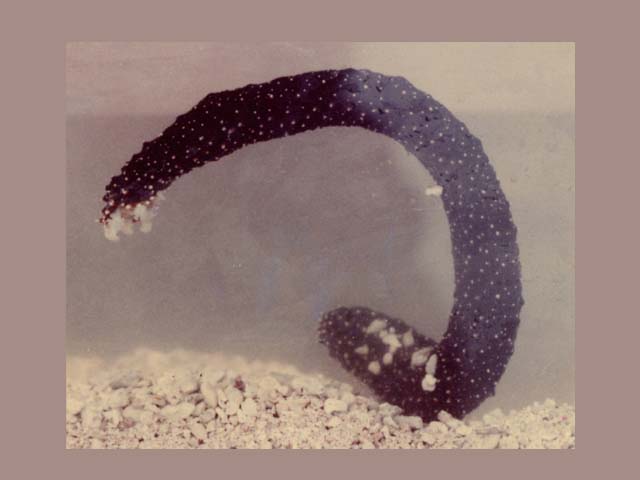| Holothuriidae (sea cucumbers) |
| 60 cm TL (male/unsexed); max.weight: 1,000.0 g |
|
reef-associated; marine; depth range 0 - 25 m |
| Pacific ocean, excluding Hawaii. |
|
Mean live weight 300 to 1000 g; body-wall thickness 0.4 cm. Body cylindrical, very elongate, larger near the posterior end. Tegument very tough. Papillae on bivium short; emerging from warts; podia on trivium conical, stout, yellow, arranged in 10 rows on the radii and interradii; calcareous disc of podia around 400 micrometer in diameter. Mouth ventral, surrounded by 20 very long, stout tentacles of characteristic yellow color; mouth also surrounded by a collar of small papillae. Anus surrounded by 5 groups of 3 small papillae. Calcareous ring with large and high radial pieces and narrow interradials. Cuvierian tubules absent. Black, with yellow podia. Spicules on tegument with tables and pseudo-buttons; tables with circular discs showing 8 holes, bearing a spire of 4 pillars, with spiny crown, hollow in the middle; pseudo-buttons plate-like with denticulate border; rods in the podia and papillae smooth, with holes at their ends; tentacles with nodulous rods. |
| Not known to be traditionally harvested, but in recent times, due to increasing demand, this species also appears in the processed products of some Pacific Islands; low commercial value. Collected by hand while wading on the reefs at low tide, or by divers. Found in moderately shallow water; mostly on inner reef flats of fringing and lagoon-islet reefs and shallow coastal lagoons; abundant on sandy-muddy grounds with rubble or coral patches, where it hides the posterior part of its body (Ref. 122). Inhabits the edges of reefs and under boulders. Feeds on the surface of sediments (Ref. 92930). Population densities between 0.1 and 0.2 per square meter (Ref. 122). |
|
(LC); Date assessed: 18 May 2010 Ref. 123251)
|
| harmless |
|
Source and more info: www.sealifebase.org. For personal, classroom, and other internal use only. Not for publication.

